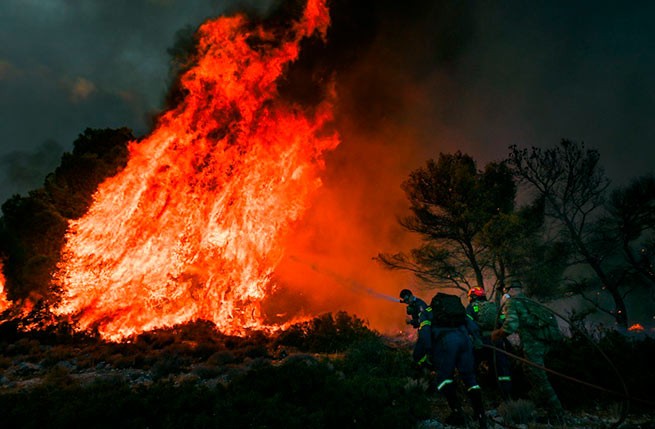The fight against the spread of fire in the Parnita National Park was confirmed by the deputy mayor of the city of Aharnon Nikos Xagoraris, who, in an interview with ERT, said that the virgin forest was on fire.
Despite the strong northeast wind, the fire rises and already entered the national parksaid the deputy mayor, stressing that we are talking about a forest that has not previously burned.
Οι κάτοικοι στην Ελλάδα που καίγεται για μια ακόμα φορά έχουν εναποθέσει τις ελπίδες τους μόνο στο Θεό..#Παρνηθα #Αλεξανδρουπολη #φωτια #πυρκαγια pic.twitter.com/MIQnEhkfrP
— Καθίκι (@KYTKYTKYTKYTKYT) August 23, 2023
The inhabitants of Greece, which is on fire again, place their hopes only in God.
The fire, uncontrolled since Tuesday at the foot of Parnita, has now reached the point where the National Park begins. Currently, the flame is moving towards the mountain at the level of the cable car.
Strong wind
The wind in Parnit became very strong, and, despite the superhuman efforts of volunteers and firefighters, constantly flaring flames moved from the forest to the courtyards of houses. Several houses surrendered to the flames in Agios Ioannis Rosos and Dardisa, while residents of the Kapota, Lefanto areas located at the foot of the mountain received messages from the 112 service to leave their homes.
https://www.youtube.com/watch?v=fBAIecsIA9k
Fire on Parnita in the area of Agios Ioannis Rosos
The fire is flaring up again in the area of Cleston Monastery, from where the initial outbreak started yesterday, which has been blazing in Parnit for the second day, threatening the national park. Due to the uncontrollable situation and strong winds that directed the flames towards the Panorama Aharnon and the Amygdaleza area, shortly after 12:25 p.m., it was decided to evacuate the Amygdaleza building, located next to the police school, as a precautionary measure. A total of 700 people are expected to be transported by bus to safety.
Meteorologist Marousakis on the fire in Parnit: where the winds will blow
“Regarding the fire in Parnit, on the map we created, you can see how the wind gusts will develop in the next few hours in accordance with the high-resolution meteorological model that we built for the entire area. With a white circle, we highlighted the area with fire fronts. Numerical values correspond to 7-8 Beaufort points.”
The natural wealth of Parnita National Park is under threat
In 1961, most of the mountain was declared a national park (founding decree BD 644/1961). The park consists of a core occupying the central part of the mountain (about 38 thousand hectares) and a peripheral zone (about 220 thousand hectares). Most of the core (90%) is covered by the forest of Abies cephalonica (Abies cephalonica), while the peripheral zone is mainly covered by the high forests of Aleppo-Pefka.
The flora of Parnita has been studied in the past by several researchers. The most significant were carried out by Halachi (1900-1904, 1908a, 1908b), Strid (1986) and Strid and Tan (1991, 1997, 2002), as well as by Diapulis (1958) and Sarlis (1994), who published floristic catalogs, which show names of plant taxa common in Parnit.
According to the latest floristic study (Aplada et al., 2007), 1096 taxa of native plants occur in Parnit, belonging to 456 genera and 90 families. The most floristically rich are the families Compositae, Leguminosae and Graminae, and the families Caryophyllaceae, Cruciferae and Liliaceae are also well represented. The biotic spectrum of the Parnit flora is dominated by therophytes (37.6%), followed by semi-cryptophytes (28.1%), geophytes (14.9%), hematophytes (10.9%), phanerophytes (8.4%) and finally , hydrophytes (0.1%). The spatial range is dominated by Mediterranean taxa (63.6%), a significant proportion of Eurasian (7.8%) and Paleo-Eurasian (7.8%) taxa.
Of greatest interest are the Greek endemic taxa found (including) in Parnit, since they should be protected as a priority. A total of 92 Greek endemic taxa have been recorded. It should be noted that 70 Greek endemics were found in the territory of the former core of the Parnita National Park. Two taxa, Campanula celsii subsp. parnesia and Silene oligantha subsp. parnesia are endemic exclusively to Parnita (Aplada et al., 2007).
However, in addition to the taxa endemic to Greece, the presence of 25 other plant taxa protected by the CITES Convention on International Trade in Endangered Species of Wild Fauna and Flora has been noted in Parnit.







More Stories
Thodoris Kolidas explains the phenomenon "black sky" on Good Friday
Black swan in the Evros river delta
The weather will turn bad on Good Friday